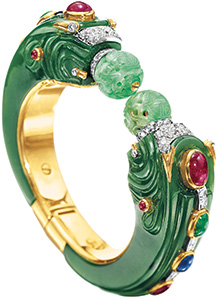|
Legacy
Fabulous Fantasies
Lions and dragons and diamonds and rock crystal…oh, my! David Webb’s made-in-America jewelry has a distinctive design vocabulary all his own.
By Phyllis Schiller

|
Carved jade, diamond and multi-gem 18-carat gold and platinum chimera cuff bracelet by David Webb designed in 1972, sold at Christie’s for $18,250 — more than twice its estimated price.
Photo courtesy
Christie’s Images Ltd. 2013.
|
From the late-1940s through the 1970s, David Webb made a name for himself as designer to the fashion-conscious American woman. The highlights of his career read like a classic American success story. Born in 1925, he left his hometown of Asheville, North Carolina, at the age of 17 to come north to New York City, finding work on 47th Street, the famed epicenter of jewelry design, opening his own firm there in 1948. By the time he was 25 years old, the jewelry, made in his own New York workshop had graced the cover of Vogue magazine. A decade later, he moved his business uptown to 57th Street and included a who’s who of society doyennes and Hollywood darlings among his clientele. Although his career was cut short in 1975, when he died of pancreatic cancer at the age of 50, his designs are still being produced today in a creative through line.
In 2010, David Webb, Inc. was bought by Mark Emanuel, Robert Sadian and Sima Ghadamian, who is no longer a partner in the firm. Co-owner Emanuel sums up the “dizzying variations of color and design of about 40,000 renderings” that Webb left behind. “David Webb’s artistic legacy cuts a broad swath across the field of mid-twentieth-century design. Bold geometries and whimsical animalia are but a small part of the archival material that we are currently exploring. The new David Webb emerges from a prologue that is jazzy and euphorically American. The continuum of quality and tradition of design continue uninterrupted as our New York workshop of 30 master jewelers creates David Webb classics and an array of archival treasures that have never been produced before.”
“David Webb was not afraid of fantasy,” states Benjamin Macklowe, vice president, Macklowe Gallery, New York City, “which made him ahead of what other people were doing in the 1950s and 1960s. And he constantly evolved. There’s a very distinct difference between the lyrical work of the 1960s and the very totemic hard-edged work of the 1970s. You can see his design evolution very clearly. His jewelry is very ‘in your face,’ it has lots of color, lots of treatments to the gold surface. He was a very innovative designer.”
“I think Webb always followed his own path with his bold designs,” agrees Daphne Lingon, senior vice president, New York Jewelry Department, Christie’s. “That’s why he became such an icon of jewelry design, especially in America. When you see his pieces, you instantly recognize them as his.”
Distinctive David Webb hallmarks, points out Audrey Friedman, co-owner with husband Haim Manishevitz of Primavera Gallery, New York City, are his extensive use of enamel and the combinations of color. She also cites the bold scale of his pieces. “In the late 1960s or early 1970s, he took a lot of inspiration from Art Deco. Reinterpreting rather than copying it, he started doing things with black enamel and coral and with rock crystal, but it was on a much larger scale.” Friedman also references his diamond jewelry, “which is very refined and very beautiful. He is credited for putting women back in yellow gold and diamonds for eveningwear.”
In fact, says Lingon, the way he used gold and how the metal was textured and treated is very much part of Webb’s jewelry vocabulary, along with the way he translated color into his designs, whether “it’s a large cabochon ruby, sapphire or emerald, or beautiful and opaque enamel.”
For Macklowe, “what’s fun about Webb is that he didn’t just use the typical things you’d expect from a jeweler. You’ll see lots of carved coral, turquoise, jade, carved emerald in his pieces, all in service of his love of color. You see that most clearly with his big sautoirs, which I think are very much on point today for fashion. On the other end of the spectrum, his very Art Deco–inspired platinum or white gold jewelry with diamonds and an abundance of rock crystal is also very popular and brings a premium, whether in the secondhand market or at auction or newly made.”
In the 1950s and 1960s, Webb did a lot of platinum jewelry, points out Janet Levy, principal, J. & S.S. DeYoung Inc. But he did it his way, she adds, citing a flower brooch he made in the late ’60s with pavéd diamond petals, edged in gold roping. The fifth petal, she explains, “is folded over. It’s very whimsical, as if it’s winking at you; it’s got a little bit of something different going on. Even with his more conservative pieces, you see this creativity coming out.”
Generally, says Lingon, “there tends to be very strong competition for Webb pieces when they come up for sale. They’re coveted.” Agrees Levy, “Webb’s jewelry has managed to hold its own. There is a segment of the marketplace for which it has had a steady appeal.”
“I don’t really think there is a bad period for Webb,” says Macklowe. “It’s all good during the time he was creating.” As long as the earrings aren’t too heavy, he says, “they sell very well, as do the necklaces. The brooches continue to sell because nobody is making anything like that.” And, says Levy, “the animal jewelry that most people associate with Webb is in tune with today’s fashions.”
“There’s definitely a premium for Webb jewelry,” sums up Macklowe. “There’s no question that he’s considered one of the great American names and as time goes on, his work will appreciate more.” Article from the Rapaport Magazine - December 2013. To subscribe click here.
|
|